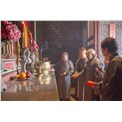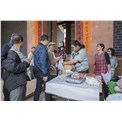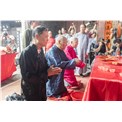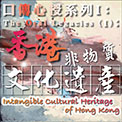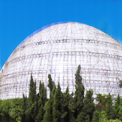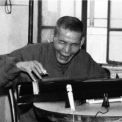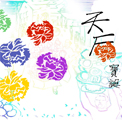 Collections
Collections The Oral Legacies Series II: The Representative List of the Intangible Cultural Heritage of Hong Kong
The Oral Legacies Series II: The Representative List of the Intangible Cultural Heritage of Hong Kong Spring and Autumn Ancestral Worship of Clans
Spring and Autumn Ancestral Worship of Clans The Ceremonies of the Spring and Autumn Ancestral Worship of Clans
The Ceremonies of the Spring and Autumn Ancestral Worship of Clans
Some clans in Hong Kong hold Spring and Autumn Ancestral Worship ceremonies every year. Other clans arrange one only, either in spring or autumn. The spring ceremony is mostly held at the ancestral hall in the second or fourth lunar month or at Vernal Equinox, while the Autumn Worship is often held at the ancestral hall or the ancestors’ graves in the ninth lunar month, at Autumnal Equinox or during the Chung Yeung Festival. Although the date and place of worship differ, Spring and Autumn Ancestral Worship of clans generally comprise three elements: worshippers, offerings and rituals.
The rituals of ancestral worship are led by the lead worshipper. He is usually the eldest and oldest of the clan. He represents the entire clan to worship the ancestors during the rituals, accompanied by co-worshippers. There are also assistants who help in preparing the offerings and taking care of the procedural matters.
The offerings for Spring and Autumn Ancestral Worship consist of the full spread of “three animal sacrifices, wine and other altar food”, including pig, chicken, fish (or other dried seafood), tea, wine, rice and soup. Some clans would additionally use five dishes of raw food and five dishes of cooked food, which include pork, chicken and offal, half of them raw and the other half cooked, placed on ten dishes. There are also auspicious fruits like apples, star fruit, grapes and tangerines, as well as lettuce, cakes and candies. The offerings will be placed in front of the ancestral tablets in the ancestral hall or, if the ceremony is held at the graveyard, in front of the tombstones. These offerings are made as a gesture of filial piety to ancestors, and as a means to pray for abundant harvests.
The highlight of the entire event is the ritual led by the lead worshipper. Before the ritual starts, the worshippers, assistants and clansmen need to put on cheongsam. The clansman who acts as master of ceremonies guides the proceedings of the ritual in a kind of chant. This is done in the Wai Tau dialect in some clans. With music in the background, the lead worshipper kneels down in front of the tablets or tombstones of the ancestors, kowtows, offers incense, makes libation, burns paper offerings, and chants the invocation. After he has completed the worship, other clansmen, cued by the master of ceremonies, will take part in the worship in the order of their seniority in the clan.
After the ceremony, assistants will distribute to clansmen red packets and pork, paid out of the ancestral asset funds. Then the whole clan will join in a sek pun (basin feast) in the ancestral hall. In the past, for the Autumn Ancestral Worship, some clans would bring along cooking utensils to cook the food for consumption on the spot, and this is known as “eating on the hillside”.

